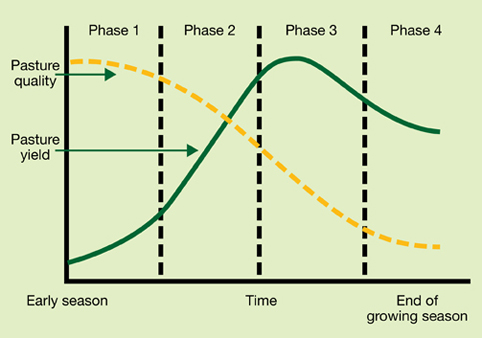Pasture growth
Pasture growth forms the basis of productivity in grazing operations. It is important for producers to understand the key factors affecting pasture growth when seeking to maximise production from native pastures. By understanding pasture growth, producers are able to maximise pasture utilisation, one of the key profit drivers, while also maintaining good land and pasture condition.
Phases of pasture growth
Pasture growth is described in three phases, followed by a fourth phase where pastures 'hay off'

By understanding these phases, producers are better able to optimise pasture utilisation. The figure above shows the changes in pasture quality and yield as pasture ages. Animal production can be increased by grazing pastures during phases 1 and 2 as quality is high. Quantity can however
be limiting during phases 1 and 2 and animal intake may be constrained.
Limit grazing in early phase 1 will assist subsequent growth - continued grazing during this period will slow pasture growth and limit production. Conversely, pastures in phase 3 will yield well but be of reduced quality.
Pasture composition
Native pastures usually consist of a mix of species including annual and perennial grasses and legumes. When grazing native pastures, producers should be aware of the plant mix in their area and the lifecycle of each species. Grazing strategies can then be adopted that preserve the natural species balance and guard against more palatable species being grazed out of existence.
These strategies are based on pasture growth phases, with grazing minimised when desirable species are becoming established or in the reproductive phase.
Perennials play an important role in native pastures maintaining land condition by providing ground cover and supporting well established root systems that help bind the soil and capture water and nutrients.
Pasture care
Overgrazing during critical growth periods, such as early in phase 1, can deplete the plant reserves and root biomass of perennial species, reducing their persistence particularly during dry periods. Dry periods will also affect the growth of annuals, often reducing the growing season and with it, the nutritional value of the pasture.
Stocking rates should be adjusted to match feed on offer as it changes with seasonal variations, within years and between years. Plans should be put in place to respond to changing conditions and seasonal variability before native pastures are overgrazed with potentially permanent effects.
One of the main threats to native pastures from overgrazing is the removal of palatable species, particularly perennials, and the introduction of weeds. Where weed infestation occurs, often after prolonged drought, herbicides may be used to restore the pasture balance. Whenever using chemicals, producers should be aware of any grazing withholding periods (WHP) and be sure to follow labelling directions.
When pastures are dormant or have dried off, supplements may be required to allow livestock to continue to utilise pastures and maintain condition. By reducing biomass through grazing, fire or mechanical means during the dormant phase, new pasture growth is encouraged when the growth cycle recommences through a rain event or favourable seasonal conditions.
Feeding the soil
Good pasture growth not only stabilises soil through root growth but also promotes other favourable soil characteristics by increasing soil organic matter levels which in turn increases water filtration and soil nutrients. Legumes will also contribute nitrogen to the soil which will promote grass growth.
Native pastures have evolved to suit the conditions and soil characteristics of the areas in which they are found. While some species will respond to fertiliser application, this needs to be managed carefully to avoid disrupting the natural balance of the pasture.
More information
- Rainfall to pasture growth outlook tool
- Evergraze
- Pasture health kit
- MLA Tips & Tools:


